service TESLA MODEL S 2015 クイックガイド (in Japanese)
[x] Cancel search | Manufacturer: TESLA, Model Year: 2015, Model line: MODEL S, Model: TESLA MODEL S 2015Pages: 96, PDF Size: 2.86 MB
Page 4 of 96
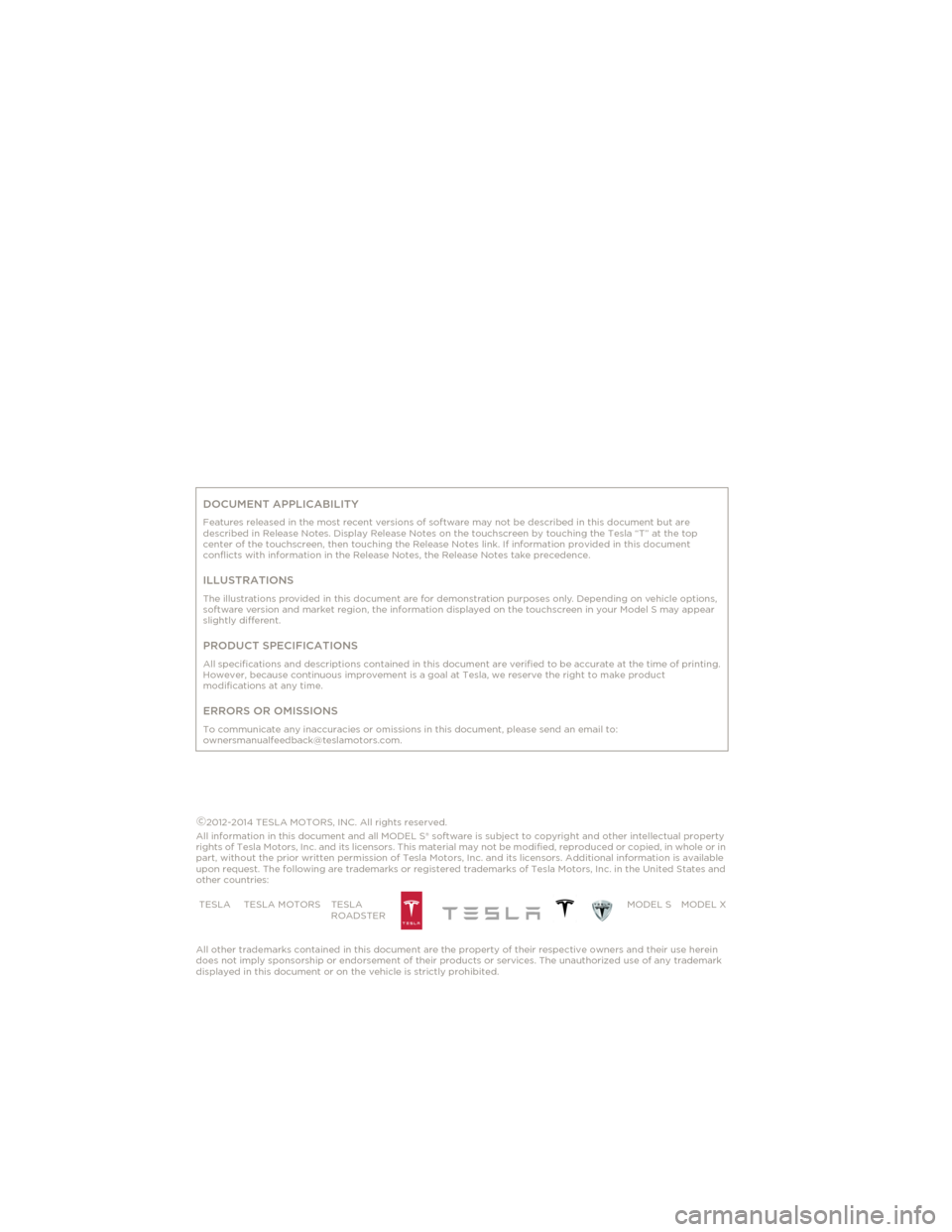
DOCUMENT APPLICABILITY
Features released in the most recent versions of software may not be described in this document but are
described in Release Notes. Display Release Notes on the touchscreen by touching the Tesla “T” at the top
center of the touchscreen, then touching the Release Notes link. If information provided in this document
conflicts with information in the Release Notes, the Release Notes take precedence.
ILLUSTRATIONS
The illustrations provided in this document are for demonstration purposes only. Depending on vehicle options,
software version and market region, the information displayed on the touchscreen in your Model S may appear
slightly different.
PRODUCT SPECIFICATIONS
All specifications and descriptions contained in this document are verified to be accurate at the time of printing.
However, because continuous improvement is a goal at Tesla, we reserve the right to make product
modifications at any time.
ERRORS OR OMISSIONS
To communicate any inaccuracies or omissions in this document, please send an email to:
ownersmanualfeedback @teslamotors.com.
©2012-2014 TESLA MOTORS, INC. All rights reserved.
All information in this document and all MODEL S® software is subject to copyright and other intellectual property
rights of Tesla Motors, Inc. and its licensors. This material may not be modified, reproduced or copied, in whole or in
part, without the prior written permission of Tesla Motors, Inc. and its licensors. Additional information is available
upon request. The following are trademarks or registered tr ademarks of Tesla Motors, Inc. in the United States and
other countries:
All other trademarks contained in this document are the property of their respective owners and their use herein
does not imply sponsorship or endorsement of their products or services. The unauthorized use of any trademark
displayed in this document or on the vehicle is strictly prohibited.
TESLA TESLA MOTORS TESLA
ROADSTER MODEL S MODEL X
Japan_Quick_Guide_1046092-00-A
.book Page 2 Friday, August 15, 2014 10:01 AM
Page 5 of 96
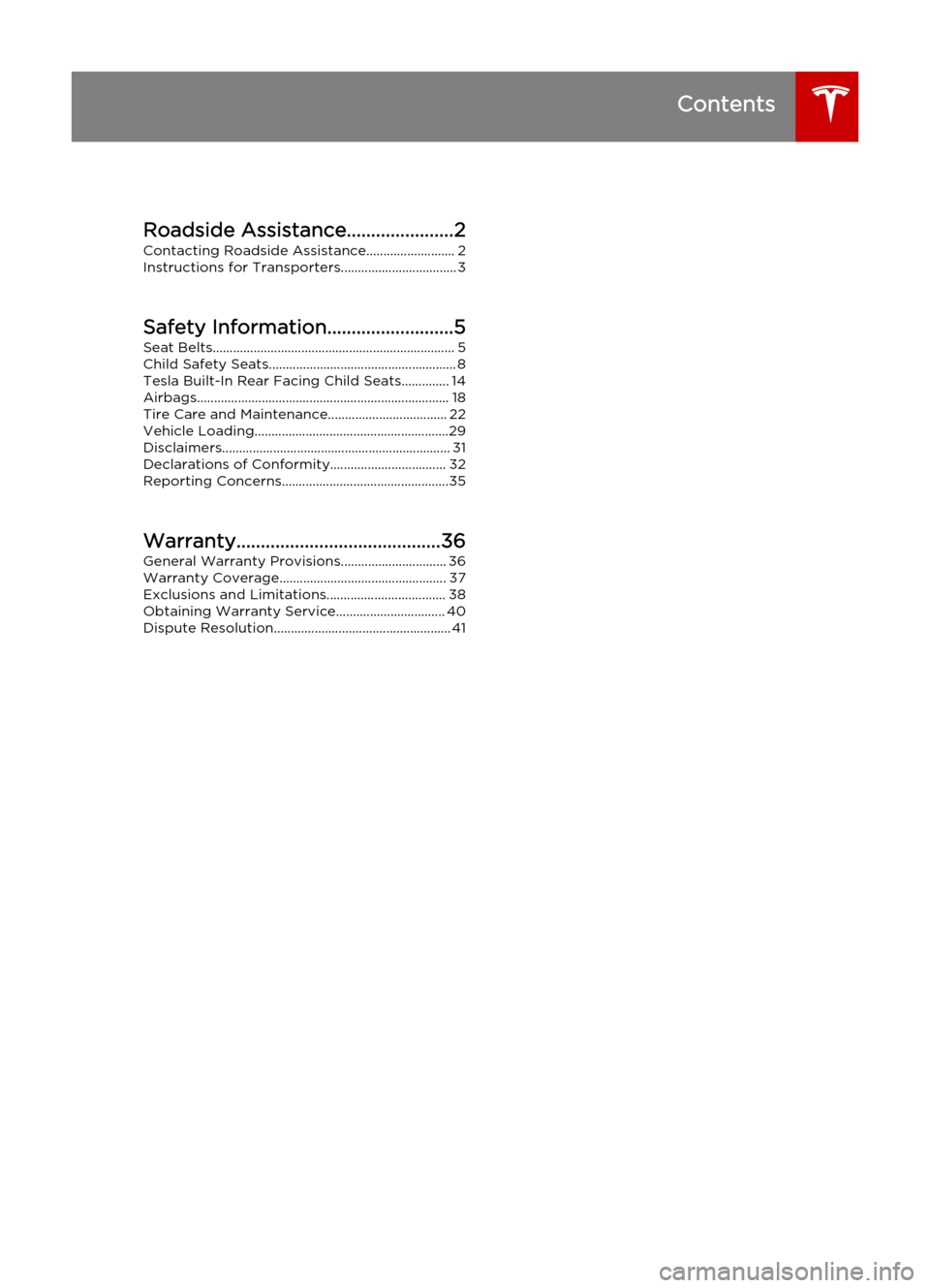
Roadside Assistance......................2Contacting Roadside Assistance.......................... 2
Instructions for Transporters.................................. 3
Use a Flatbed Only 3Disable Self-Leveling (air suspension vehicles only) 3Activate Tow Mode 3Connect the Tow Chain 4Pull Onto the Trailer and Secure the Wheels 4
Safety Information..........................5Seat Belts....................................................................... 5
Wearing Seat Belts 5Wearing Seat Belts When Pregnant 6Seat Belt Pre-tensioners 6Testing Seat Belts 7Seat Belt Warnings 7
Child Safety Seats....................................................... 8
Guidelines for Seating Children 8Choosing a Child Safety Seat 9Seating Larger Children 11Installing Child Safety Seats 11Installing Seat Belt Retained Child Seats 11Installing ISOFIXChild Seats 12Attaching Upper Tether Straps 12Testing a Child Safety Seat 13Warnings - Child Safety Seats 13
Tesla Built-In Rear Facing Child Seats.............. 14
Usage Restrictions 14Opening 14Folding 15Seating a Child 16Warnings - Tesla Child Seats 17
Airbags.......................................................................... 18
Location of Airbags 18How the Airbags Work 19Types of Airbags 19Disabling the Passenger Front Airbags 20Inflation Effects 21Airbag Warning Indicator 21Airbag Warnings 21
Tire Care and Maintenance................................... 22
Maintaining Tire Pressures 22Inspecting and Maintaining Tires 23Replacing Tires and Wheels 24Using Tire Chains 25Tire Pressure Monitoring 25Understanding Tire Markings 27
Vehicle Loading.........................................................29
Load Capacity Labeling 29Calculating Load Limits 30Towing a Trailer 30Roof Racks 30
Disclaimers................................................................... 31
Vehicle Telematics/Data Recorders 31Quality Control 31
Declarations of Conformity.................................. 32
Key and Passive Unlocking System 32Tire Pressure Monitoring System 33Media Control Unit 33Radio Frequency Information 34
Reporting Concerns.................................................35
Contacting Tesla 35
Warranty..........................................36General Warranty Provisions............................... 36
Who is the Warrantor? 36What Vehicles are Covered? 36Multiple Warranty Conditions 36Limitations and Disclaimers 36Ownership Transfer 36Who Can Enforce this New Vehicle Limited Warranty? 37When Does the Warranty Period Begin and End? 37
Warranty Coverage................................................. 37
Basic Vehicle Limited Warranty 37Supplemental Restraint System Limited Warranty 37Battery and Drive Unit Limited Warranty 38
Exclusions and Limitations................................... 38
Warranty Limitations 38Additional Limitations and Exclusions 39Voided Warranty 40Damages 40
Obtaining Warranty Service................................ 40
Payment of Tax for Repairs 41Reasonable Time for Repairs 41Roadside Assistance (Japan) 41Modifications and Waivers 41
Dispute Resolution.................................................... 41Contents
Page 21 of 96
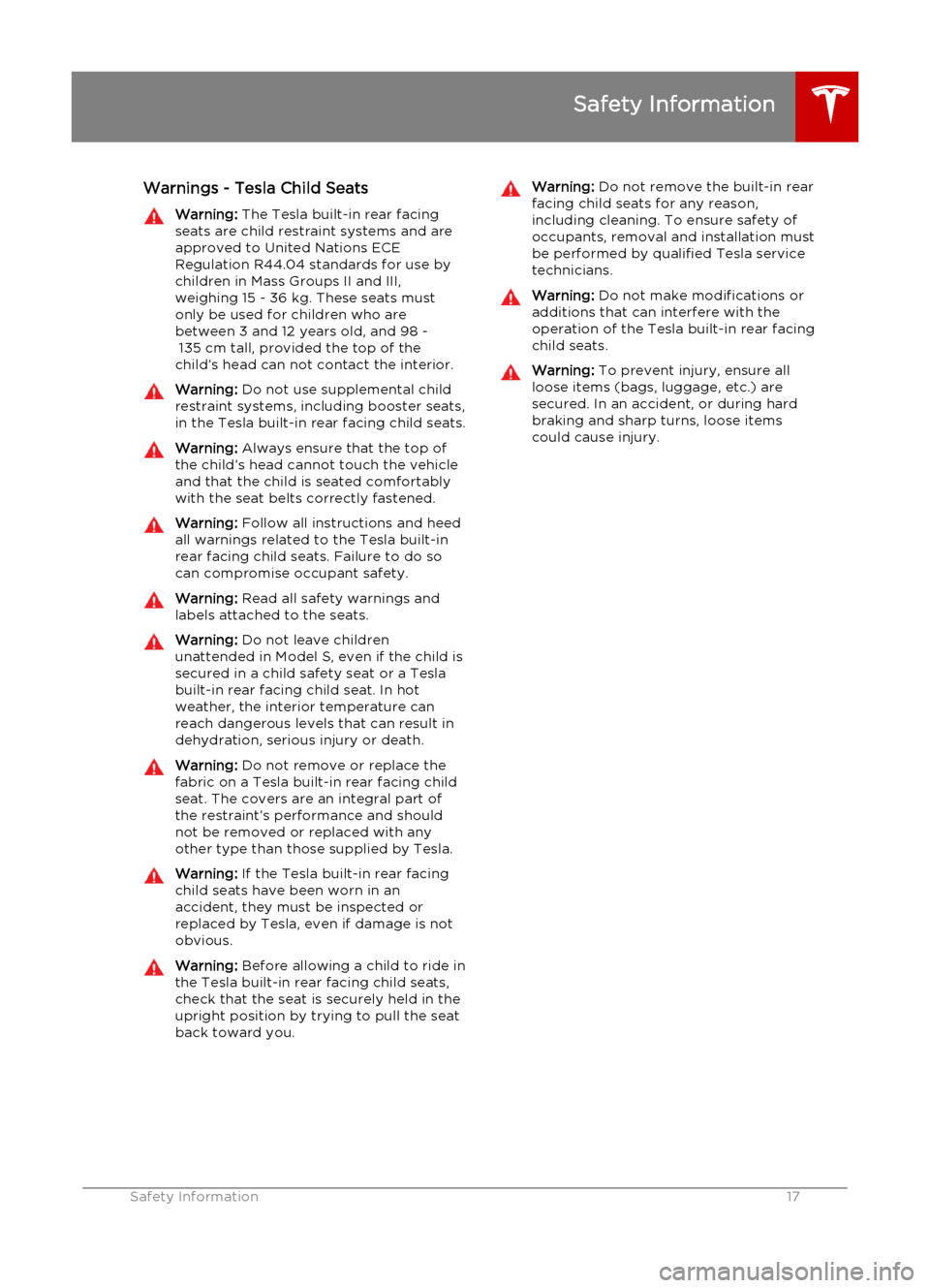
Warnings - Tesla Child SeatsWarning: The Tesla built-in rear facing
seats are child restraint systems and are approved to United Nations ECE
Regulation R44.04 standards for use by children in Mass Groups II and III,
weighing 15 - 36 kg. These seats must
only be used for children who are
between 3 and 12 years old, and 98 -
135 cm tall, provided the top of the
child’s head can not contact the interior.Warning: Do not use supplemental child
restraint systems, including booster seats,
in the Tesla built-in rear facing child seats.Warning: Always ensure that the top of
the child’s head cannot touch the vehicle and that the child is seated comfortablywith the seat belts correctly fastened.Warning: Follow all instructions and heed
all warnings related to the Tesla built-in
rear facing child seats. Failure to do so
can compromise occupant safety.Warning: Read all safety warnings and
labels attached to the seats.Warning: Do not leave children
unattended in Model S, even if the child is secured in a child safety seat or a Tesla
built-in rear facing child seat. In hot
weather, the interior temperature can reach dangerous levels that can result in
dehydration, serious injury or death.Warning: Do not remove or replace the
fabric on a Tesla built-in rear facing child
seat. The covers are an integral part of the restraint’s performance and shouldnot be removed or replaced with any
other type than those supplied by Tesla.Warning: If the Tesla built-in rear facing
child seats have been worn in an
accident, they must be inspected or
replaced by Tesla, even if damage is not
obvious.Warning: Before allowing a child to ride in
the Tesla built-in rear facing child seats, check that the seat is securely held in theupright position by trying to pull the seat
back toward you.Warning: Do not remove the built-in rear
facing child seats for any reason,
including cleaning. To ensure safety of
occupants, removal and installation must
be performed by qualified Tesla service
technicians.Warning: Do not make modifications or
additions that can interfere with the
operation of the Tesla built-in rear facing
child seats.Warning: To prevent injury, ensure all
loose items (bags, luggage, etc.) are
secured. In an accident, or during hard
braking and sharp turns, loose items
could cause injury.
Safety Information
Safety Information17
Page 27 of 96
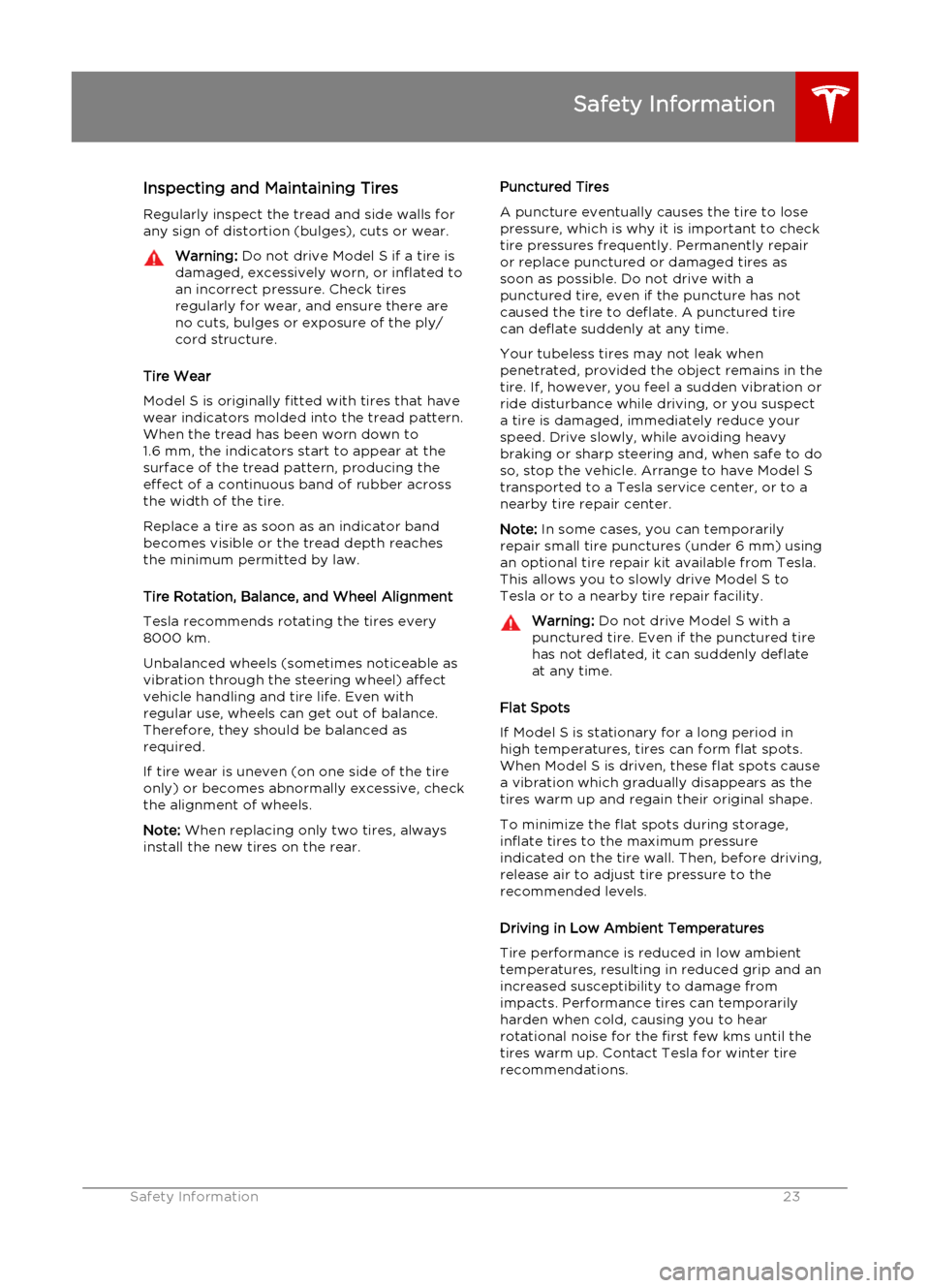
Inspecting and Maintaining TiresRegularly inspect the tread and side walls for
any sign of distortion (bulges), cuts or wear.Warning: Do not drive Model S if a tire is
damaged, excessively worn, or inflated to
an incorrect pressure. Check tires
regularly for wear, and ensure there are
no cuts, bulges or exposure of the ply/
cord structure.
Tire Wear
Model S is originally fitted with tires that have wear indicators molded into the tread pattern.
When the tread has been worn down to
1.6 mm, the indicators start to appear at the
surface of the tread pattern, producing the effect of a continuous band of rubber across
the width of the tire.
Replace a tire as soon as an indicator band
becomes visible or the tread depth reaches the minimum permitted by law.
Tire Rotation, Balance, and Wheel Alignment
Tesla recommends rotating the tires every 8000 km.
Unbalanced wheels (sometimes noticeable as vibration through the steering wheel) affect
vehicle handling and tire life. Even with
regular use, wheels can get out of balance.
Therefore, they should be balanced as
required.
If tire wear is uneven (on one side of the tire
only) or becomes abnormally excessive, check
the alignment of wheels.
Note: When replacing only two tires, always
install the new tires on the rear.
Punctured Tires
A puncture eventually causes the tire to lose
pressure, which is why it is important to check
tire pressures frequently. Permanently repair
or replace punctured or damaged tires as
soon as possible. Do not drive with a
punctured tire, even if the puncture has not
caused the tire to deflate. A punctured tire
can deflate suddenly at any time.
Your tubeless tires may not leak when
penetrated, provided the object remains in the
tire. If, however, you feel a sudden vibration or
ride disturbance while driving, or you suspect
a tire is damaged, immediately reduce your
speed. Drive slowly, while avoiding heavy
braking or sharp steering and, when safe to do
so, stop the vehicle. Arrange to have Model S
transported to a Tesla service center, or to a
nearby tire repair center.
Note: In some cases, you can temporarily
repair small tire punctures (under 6 mm) using
an optional tire repair kit available from Tesla. This allows you to slowly drive Model S to
Tesla or to a nearby tire repair facility.Warning: Do not drive Model S with a
punctured tire. Even if the punctured tire has not deflated, it can suddenly deflate
at any time.
Flat Spots
If Model S is stationary for a long period in
high temperatures, tires can form flat spots. When Model S is driven, these flat spots causea vibration which gradually disappears as thetires warm up and regain their original shape.
To minimize the flat spots during storage,
inflate tires to the maximum pressure
indicated on the tire wall. Then, before driving, release air to adjust tire pressure to the
recommended levels.
Driving in Low Ambient Temperatures
Tire performance is reduced in low ambient temperatures, resulting in reduced grip and an
increased susceptibility to damage from
impacts. Performance tires can temporarily
harden when cold, causing you to hear
rotational noise for the first few kms until the tires warm up. Contact Tesla for winter tire
recommendations.
Safety Information
Safety Information23
Page 29 of 96
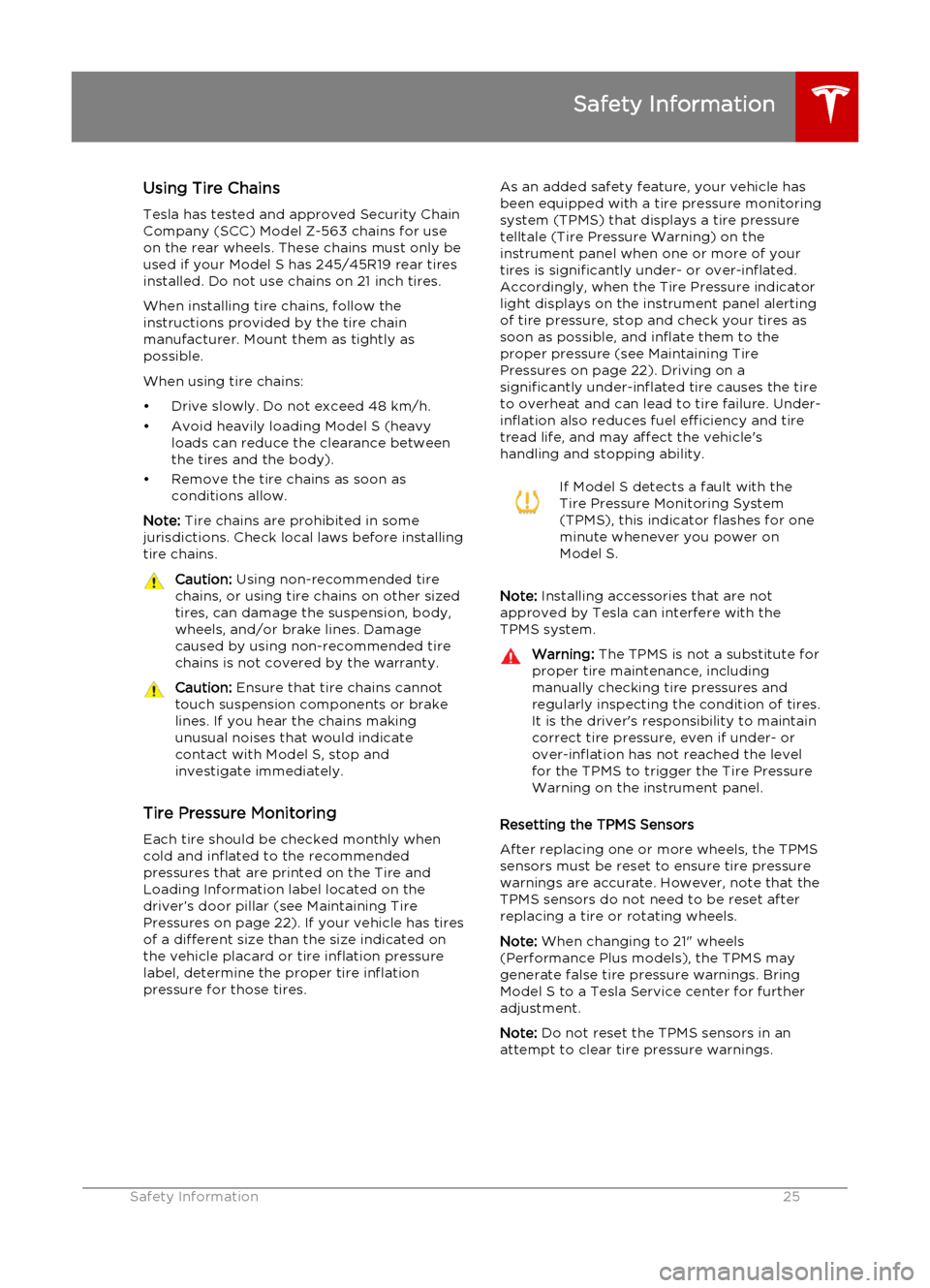
Using Tire ChainsTesla has tested and approved Security Chain
Company (SCC) Model Z-563 chains for use
on the rear wheels. These chains must only be
used if your Model S has 245/45R19 rear tires
installed. Do not use chains on 21 inch tires.
When installing tire chains, follow the
instructions provided by the tire chain
manufacturer. Mount them as tightly as
possible.
When using tire chains:
• Drive slowly. Do not exceed 48 km/h.
• Avoid heavily loading Model S (heavy loads can reduce the clearance betweenthe tires and the body).
• Remove the tire chains as soon as conditions allow.
Note: Tire chains are prohibited in some
jurisdictions. Check local laws before installing
tire chains.Caution: Using non-recommended tire
chains, or using tire chains on other sized tires, can damage the suspension, body,wheels, and/or brake lines. Damagecaused by using non-recommended tire
chains is not covered by the warranty.Caution: Ensure that tire chains cannot
touch suspension components or brake
lines. If you hear the chains making
unusual noises that would indicate
contact with Model S, stop and
investigate immediately.
Tire Pressure Monitoring
Each tire should be checked monthly when
cold and inflated to the recommended
pressures that are printed on the Tire and
Loading Information label located on the
driver’s door pillar (see Maintaining Tire Pressures on page 22). If your vehicle has tires
of a different size than the size indicated on
the vehicle placard or tire inflation pressure
label, determine the proper tire inflation
pressure for those tires.
As an added safety feature, your vehicle has
been equipped with a tire pressure monitoring system (TPMS) that displays a tire pressuretelltale (Tire Pressure Warning) on the
instrument panel when one or more of your
tires is significantly under- or over-inflated.
Accordingly, when the Tire Pressure indicator
light displays on the instrument panel alerting
of tire pressure, stop and check your tires as
soon as possible, and inflate them to the proper pressure (see Maintaining TirePressures on page 22). Driving on a
significantly under-inflated tire causes the tire
to overheat and can lead to tire failure. Under-
inflation also reduces fuel efficiency and tire
tread life, and may affect the vehicle's
handling and stopping ability.If Model S detects a fault with the
Tire Pressure Monitoring System
(TPMS), this indicator flashes for one
minute whenever you power on
Model S.
Note: Installing accessories that are not
approved by Tesla can interfere with the TPMS system.
Warning: The TPMS is not a substitute for
proper tire maintenance, including
manually checking tire pressures and
regularly inspecting the condition of tires.
It is the driver's responsibility to maintain
correct tire pressure, even if under- or
over-inflation has not reached the level
for the TPMS to trigger the Tire Pressure Warning on the instrument panel.
Resetting the TPMS Sensors
After replacing one or more wheels, the TPMS sensors must be reset to ensure tire pressurewarnings are accurate. However, note that theTPMS sensors do not need to be reset after
replacing a tire or rotating wheels.
Note: When changing to 21" wheels
(Performance Plus models), the TPMS may
generate false tire pressure warnings. Bring
Model S to a Tesla Service center for further
adjustment.
Note: Do not reset the TPMS sensors in an
attempt to clear tire pressure warnings.
Safety Information
Safety Information25
Page 30 of 96
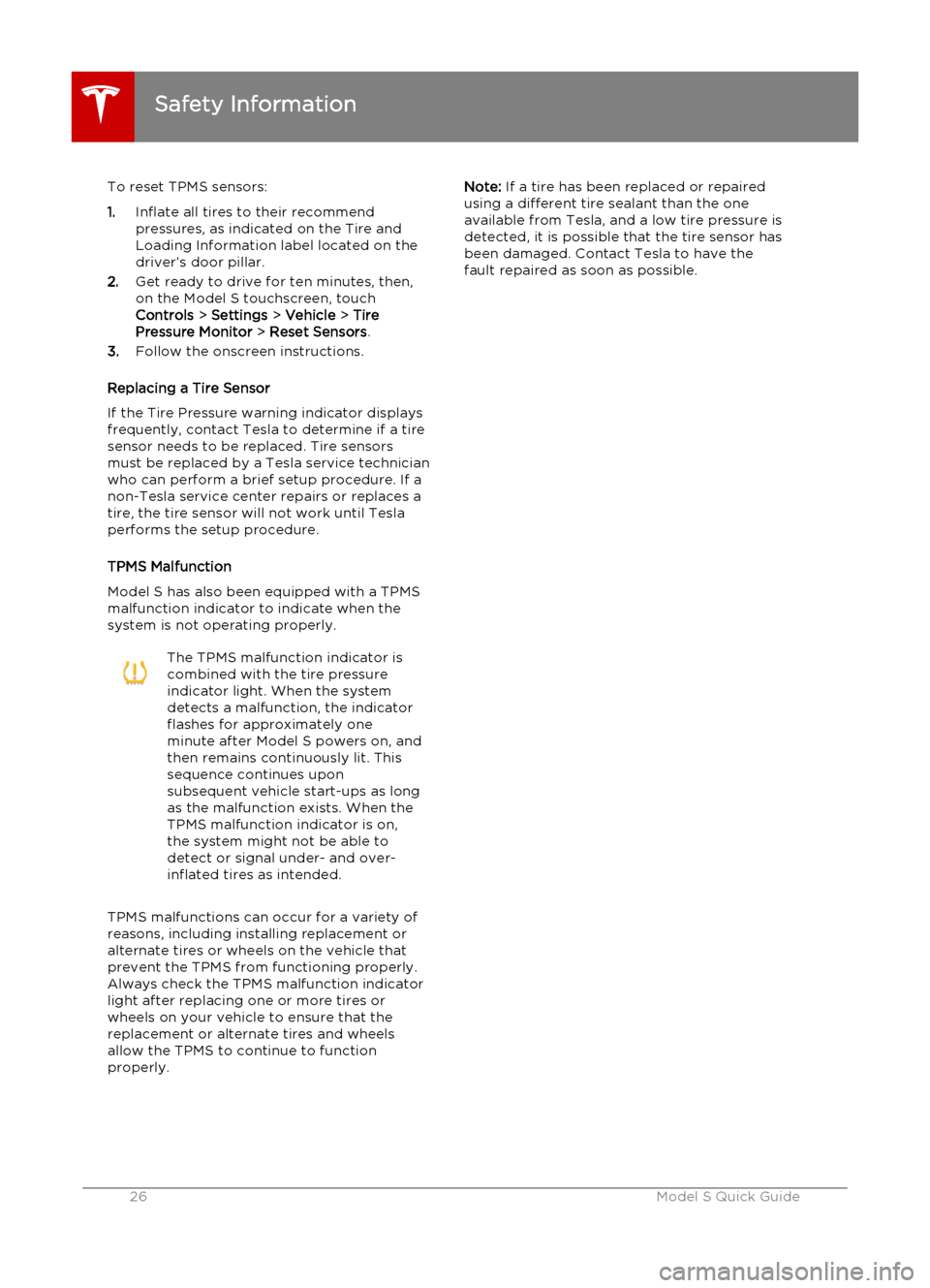
To reset TPMS sensors:
1. Inflate all tires to their recommend
pressures, as indicated on the Tire and
Loading Information label located on the
driver’s door pillar.
2. Get ready to drive for ten minutes, then,
on the Model S touchscreen, touch
Controls > Settings > Vehicle > Tire
Pressure Monitor > Reset Sensors .
3. Follow the onscreen instructions.
Replacing a Tire Sensor
If the Tire Pressure warning indicator displays
frequently, contact Tesla to determine if a tire
sensor needs to be replaced. Tire sensors
must be replaced by a Tesla service technician
who can perform a brief setup procedure. If a
non-Tesla service center repairs or replaces a
tire, the tire sensor will not work until Tesla
performs the setup procedure.
TPMS Malfunction
Model S has also been equipped with a TPMS
malfunction indicator to indicate when the
system is not operating properly.The TPMS malfunction indicator is
combined with the tire pressure
indicator light. When the system
detects a malfunction, the indicator
flashes for approximately one
minute after Model S powers on, and
then remains continuously lit. This
sequence continues upon
subsequent vehicle start-ups as long
as the malfunction exists. When the
TPMS malfunction indicator is on,
the system might not be able to
detect or signal under- and over-
inflated tires as intended.
TPMS malfunctions can occur for a variety of
reasons, including installing replacement oralternate tires or wheels on the vehicle thatprevent the TPMS from functioning properly.Always check the TPMS malfunction indicator
light after replacing one or more tires or
wheels on your vehicle to ensure that the replacement or alternate tires and wheels
allow the TPMS to continue to function
properly.
Note: If a tire has been replaced or repaired
using a different tire sealant than the one
available from Tesla, and a low tire pressure is
detected, it is possible that the tire sensor has
been damaged. Contact Tesla to have the
fault repaired as soon as possible.
Safety Information
26Model S Quick Guide
Page 35 of 96
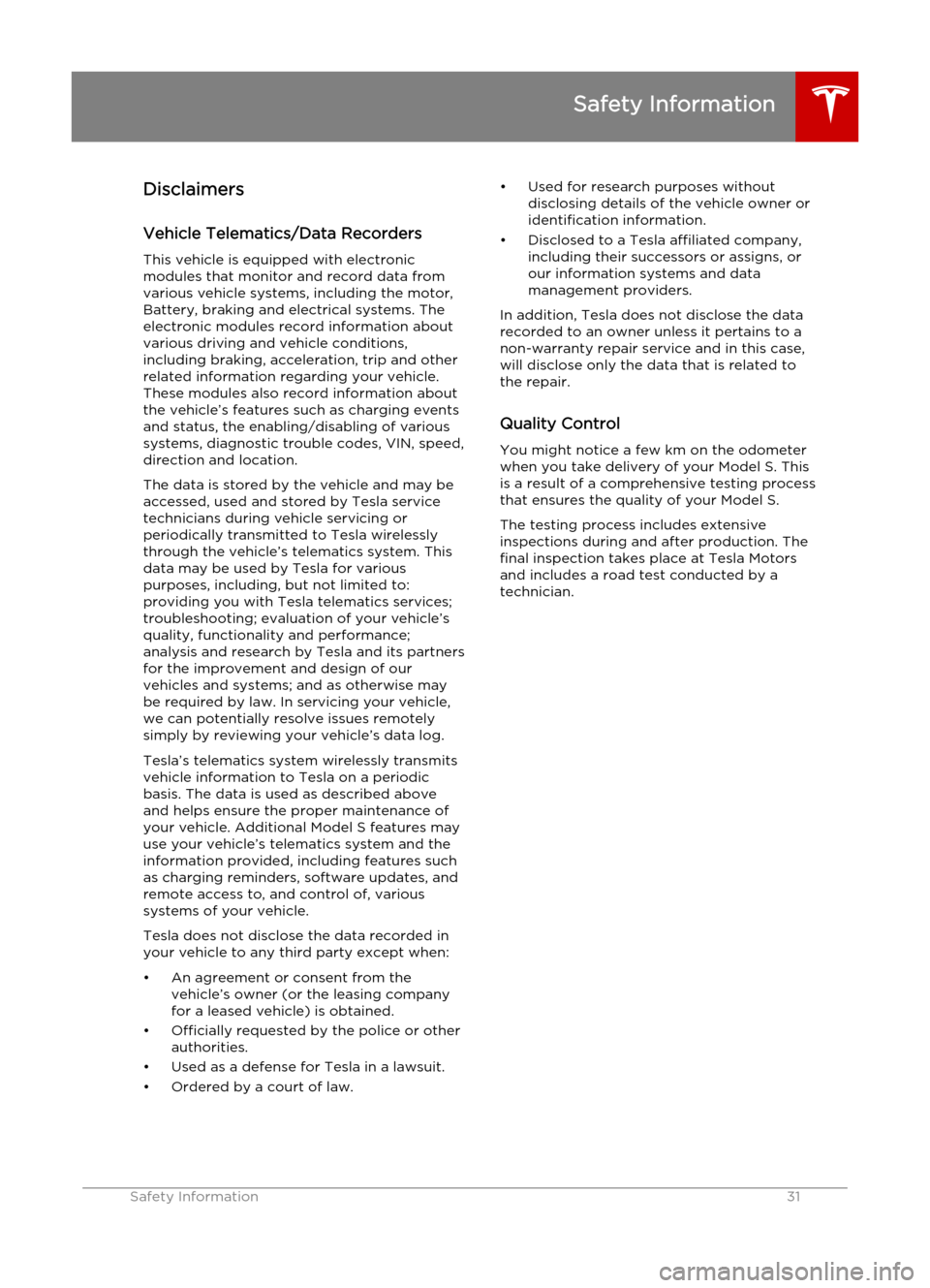
DisclaimersVehicle Telematics/Data RecordersThis vehicle is equipped with electronic
modules that monitor and record data from
various vehicle systems, including the motor,
Battery, braking and electrical systems. The
electronic modules record information about
various driving and vehicle conditions,
including braking, acceleration, trip and other
related information regarding your vehicle.
These modules also record information about
the vehicle’s features such as charging events
and status, the enabling/disabling of various
systems, diagnostic trouble codes, VIN, speed,
direction and location.
The data is stored by the vehicle and may be
accessed, used and stored by Tesla service
technicians during vehicle servicing or
periodically transmitted to Tesla wirelessly
through the vehicle’s telematics system. This
data may be used by Tesla for various
purposes, including, but not limited to:
providing you with Tesla telematics services;
troubleshooting; evaluation of your vehicle’s
quality, functionality and performance;
analysis and research by Tesla and its partners
for the improvement and design of our
vehicles and systems; and as otherwise may
be required by law. In servicing your vehicle,
we can potentially resolve issues remotely
simply by reviewing your vehicle’s data log.
Tesla’s telematics system wirelessly transmits
vehicle information to Tesla on a periodic
basis. The data is used as described above and helps ensure the proper maintenance of
your vehicle. Additional Model S features may
use your vehicle’s telematics system and the
information provided, including features such
as charging reminders, software updates, and
remote access to, and control of, various
systems of your vehicle.
Tesla does not disclose the data recorded in
your vehicle to any third party except when:
• An agreement or consent from the vehicle’s owner (or the leasing companyfor a leased vehicle) is obtained.
• Officially requested by the police or other authorities.
• Used as a defense for Tesla in a lawsuit. • Ordered by a court of law.• Used for research purposes without disclosing details of the vehicle owner or
identification information.
• Disclosed to a Tesla affiliated company, including their successors or assigns, or
our information systems and data
management providers.
In addition, Tesla does not disclose the data
recorded to an owner unless it pertains to a
non-warranty repair service and in this case,
will disclose only the data that is related to the repair.
Quality Control You might notice a few km on the odometer
when you take delivery of your Model S. This is a result of a comprehensive testing process
that ensures the quality of your Model S.
The testing process includes extensive
inspections during and after production. The final inspection takes place at Tesla Motors
and includes a road test conducted by a
technician.
Safety Information
Safety Information31
Page 40 of 96
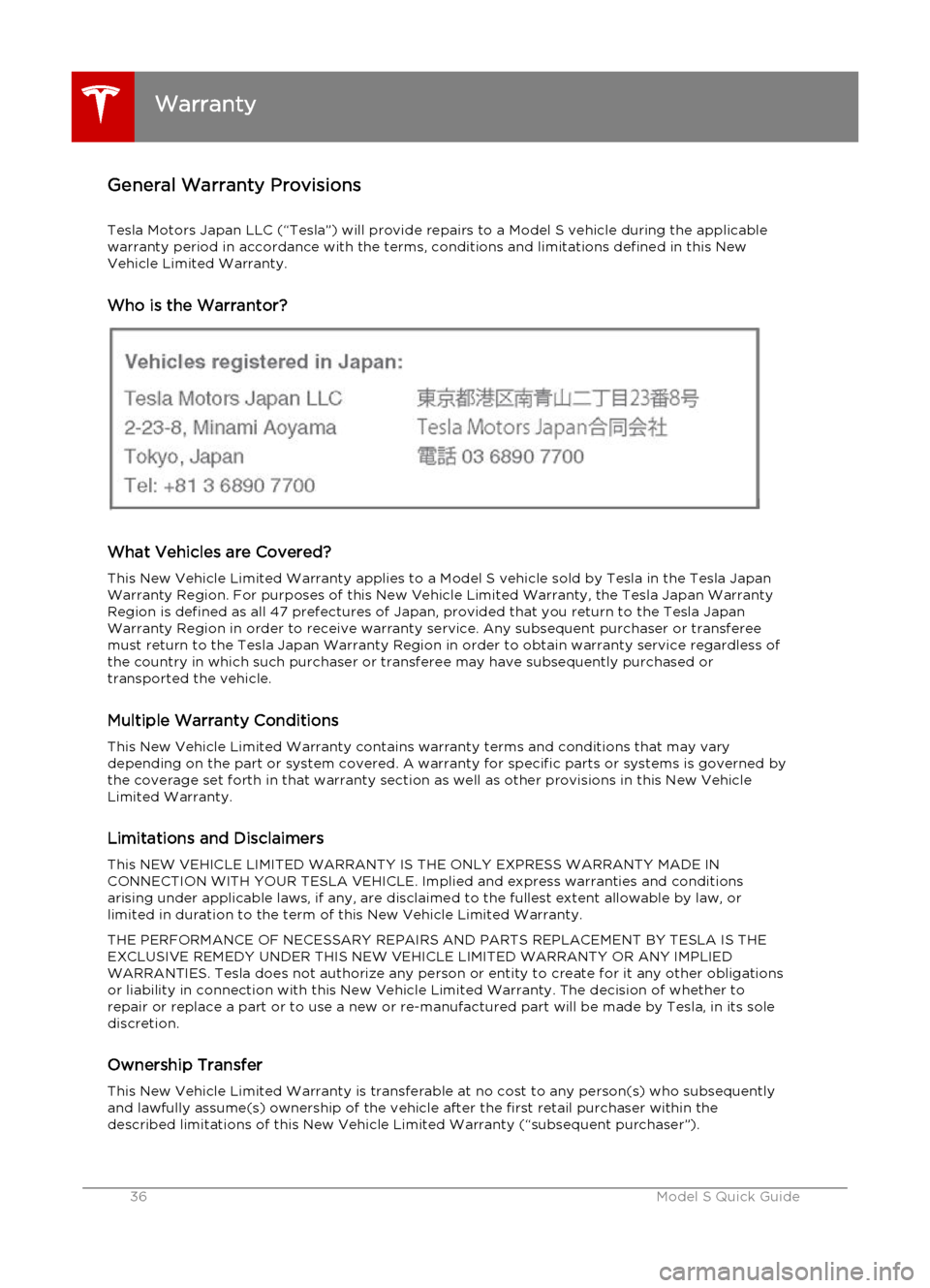
General Warranty ProvisionsTesla Motors Japan LLC (“Tesla”) will provide repairs to a Model S vehicle during the applicablewarranty period in accordance with the terms, conditions and limitations defined in this New
Vehicle Limited Warranty.
Who is the Warrantor?
What Vehicles are Covered?
This New Vehicle Limited Warranty applies to a Model S vehicle sold by Tesla in the Tesla Japan Warranty Region. For purposes of this New Vehicle Limited Warranty, the Tesla Japan Warranty
Region is defined as all 47 prefectures of Japan, provided that you return to the Tesla Japan
Warranty Region in order to receive warranty service. Any subsequent purchaser or transferee
must return to the Tesla Japan Warranty Region in order to obtain warranty service regardless of
the country in which such purchaser or transferee may have subsequently purchased or
transported the vehicle.
Multiple Warranty Conditions
This New Vehicle Limited Warranty contains warranty terms and conditions that may vary
depending on the part or system covered. A warranty for specific parts or systems is governed by
the coverage set forth in that warranty section as well as other provisions in this New Vehicle
Limited Warranty.
Limitations and Disclaimers This NEW VEHICLE LIMITED WARRANTY IS THE ONLY EXPRESS WARRANTY MADE INCONNECTION WITH YOUR TESLA VEHICLE. Implied and express warranties and conditions
arising under applicable laws, if any, are disclaimed to the fullest extent allowable by law, or limited in duration to the term of this New Vehicle Limited Warranty.
THE PERFORMANCE OF NECESSARY REPAIRS AND PARTS REPLACEMENT BY TESLA IS THE EXCLUSIVE REMEDY UNDER THIS NEW VEHICLE LIMITED WARRANTY OR ANY IMPLIEDWARRANTIES. Tesla does not authorize any person or entity to create for it any other obligationsor liability in connection with this New Vehicle Limited Warranty. The decision of whether to
repair or replace a part or to use a new or re-manufactured part will be made by Tesla, in its sole discretion.
Ownership Transfer
This New Vehicle Limited Warranty is transferable at no cost to any person(s) who subsequently
and lawfully assume(s) ownership of the vehicle after the first retail purchaser within the
described limitations of this New Vehicle Limited Warranty (“subsequent purchaser”).
Warranty
36Model S Quick Guide
Page 42 of 96
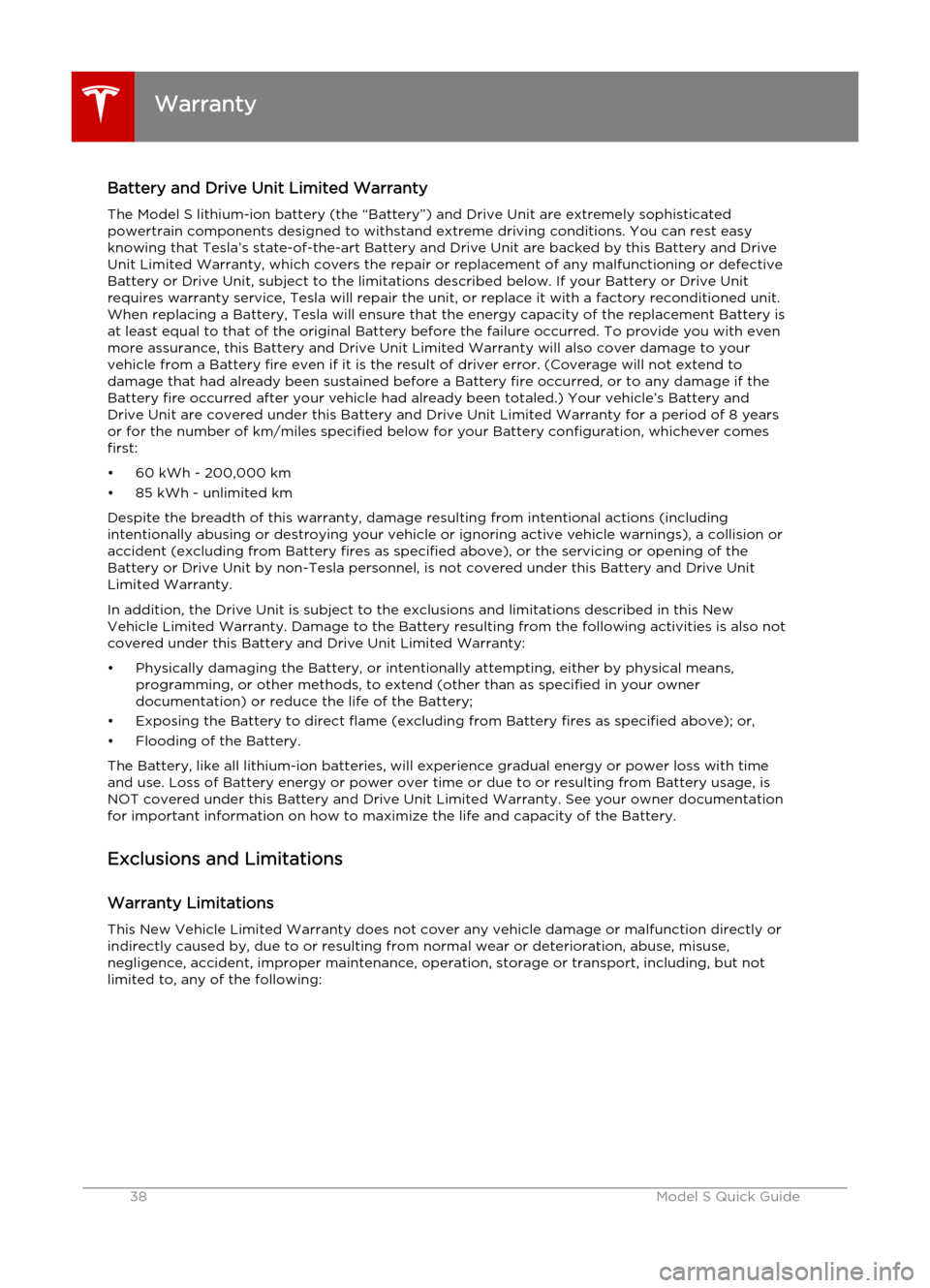
Battery and Drive Unit Limited WarrantyThe Model S lithium-ion battery (the “Battery”) and Drive Unit are extremely sophisticatedpowertrain components designed to withstand extreme driving conditions. You can rest easy
knowing that Tesla’s state-of-the-art Battery and Drive Unit are backed by this Battery and Drive
Unit Limited Warranty, which covers the repair or replacement of any malfunctioning or defective
Battery or Drive Unit, subject to the limitations described below. If your Battery or Drive Unit
requires warranty service, Tesla will repair the unit, or replace it with a factory reconditioned unit.
When replacing a Battery, Tesla will ensure that the energy capacity of the replacement Battery is
at least equal to that of the original Battery before the failure occurred. To provide you with even
more assurance, this Battery and Drive Unit Limited Warranty will also cover damage to your
vehicle from a Battery fire even if it is the result of driver error. (Coverage will not extend to
damage that had already been sustained before a Battery fire occurred, or to any damage if the
Battery fire occurred after your vehicle had already been totaled.) Your vehicle’s Battery and
Drive Unit are covered under this Battery and Drive Unit Limited Warranty for a period of 8 years or for the number of km/miles specified below for your Battery configuration, whichever comesfirst:
• 60 kWh - 200,000 km
• 85 kWh - unlimited km
Despite the breadth of this warranty, damage resulting from intentional actions (including intentionally abusing or destroying your vehicle or ignoring active vehicle warnings), a collision or accident (excluding from Battery fires as specified above), or the servicing or opening of the
Battery or Drive Unit by non-Tesla personnel, is not covered under this Battery and Drive Unit
Limited Warranty.
In addition, the Drive Unit is subject to the exclusions and limitations described in this New
Vehicle Limited Warranty. Damage to the Battery resulting from the following activities is also not covered under this Battery and Drive Unit Limited Warranty:
• Physically damaging the Battery, or intentionally attempting, either by physical means, programming, or other methods, to extend (other than as specified in your owner
documentation) or reduce the life of the Battery;
• Exposing the Battery to direct flame (excluding from Battery fires as specified above); or,
• Flooding of the Battery.
The Battery, like all lithium-ion batteries, will experience gradual energy or power loss with time and use. Loss of Battery energy or power over time or due to or resulting from Battery usage, is
NOT covered under this Battery and Drive Unit Limited Warranty. See your owner documentation for important information on how to maximize the life and capacity of the Battery.
Exclusions and Limitations
Warranty Limitations This New Vehicle Limited Warranty does not cover any vehicle damage or malfunction directly orindirectly caused by, due to or resulting from normal wear or deterioration, abuse, misuse,
negligence, accident, improper maintenance, operation, storage or transport, including, but not
limited to, any of the following:
Warranty
38Model S Quick Guide
Page 43 of 96
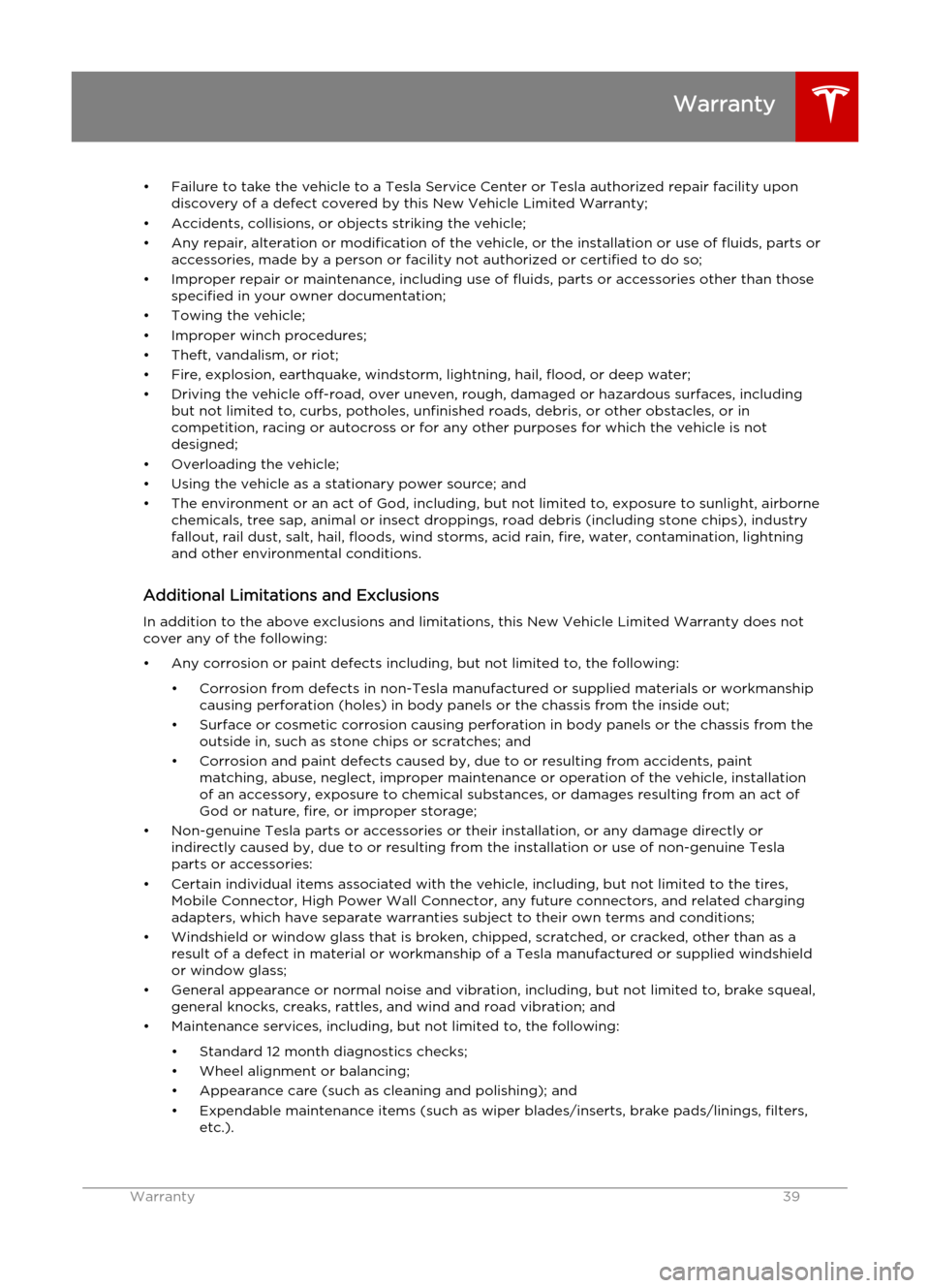
• Failure to take the vehicle to a Tesla Service Center or Tesla authorized repair facility upondiscovery of a defect covered by this New Vehicle Limited Warranty;
• Accidents, collisions, or objects striking the vehicle; • Any repair, alteration or modification of the vehicle, or the installation or use of fluids, parts or accessories, made by a person or facility not authorized or certified to do so;
• Improper repair or maintenance, including use of fluids, parts or accessories other than those specified in your owner documentation;
• Towing the vehicle;
• Improper winch procedures;
• Theft, vandalism, or riot; • Fire, explosion, earthquake, windstorm, lightning, hail, flood, or deep water;
• Driving the vehicle off-road, over uneven, rough, damaged or hazardous surfaces, including but not limited to, curbs, potholes, unfinished roads, debris, or other obstacles, or in
competition, racing or autocross or for any other purposes for which the vehicle is not
designed;
• Overloading the vehicle;
• Using the vehicle as a stationary power source; and
• The environment or an act of God, including, but not limited to, exposure to sunlight, airborne chemicals, tree sap, animal or insect droppings, road debris (including stone chips), industryfallout, rail dust, salt, hail, floods, wind storms, acid rain, fire, water, contamination, lightning
and other environmental conditions.
Additional Limitations and Exclusions
In addition to the above exclusions and limitations, this New Vehicle Limited Warranty does not
cover any of the following:
• Any corrosion or paint defects including, but not limited to, the following: • Corrosion from defects in non-Tesla manufactured or supplied materials or workmanship causing perforation (holes) in body panels or the chassis from the inside out;
• Surface or cosmetic corrosion causing perforation in body panels or the chassis from the outside in, such as stone chips or scratches; and
• Corrosion and paint defects caused by, due to or resulting from accidents, paint matching, abuse, neglect, improper maintenance or operation of the vehicle, installation
of an accessory, exposure to chemical substances, or damages resulting from an act of
God or nature, fire, or improper storage;
• Non-genuine Tesla parts or accessories or their installation, or any damage directly or indirectly caused by, due to or resulting from the installation or use of non-genuine Teslaparts or accessories:
• Certain individual items associated with the vehicle, including, but not limited to the tires, Mobile Connector, High Power Wall Connector, any future connectors, and related charging
adapters, which have separate warranties subject to their own terms and conditions;
• Windshield or window glass that is broken, chipped, scratched, or cracked, other than as a result of a defect in material or workmanship of a Tesla manufactured or supplied windshieldor window glass;
• General appearance or normal noise and vibration, including, but not limited to, brake squeal, general knocks, creaks, rattles, and wind and road vibration; and
• Maintenance services, including, but not limited to, the following:
• Standard 12 month diagnostics checks;• Wheel alignment or balancing;
• Appearance care (such as cleaning and polishing); and • Expendable maintenance items (such as wiper blades/inserts, brake pads/linings, filters, etc.).
Warranty
Warranty39